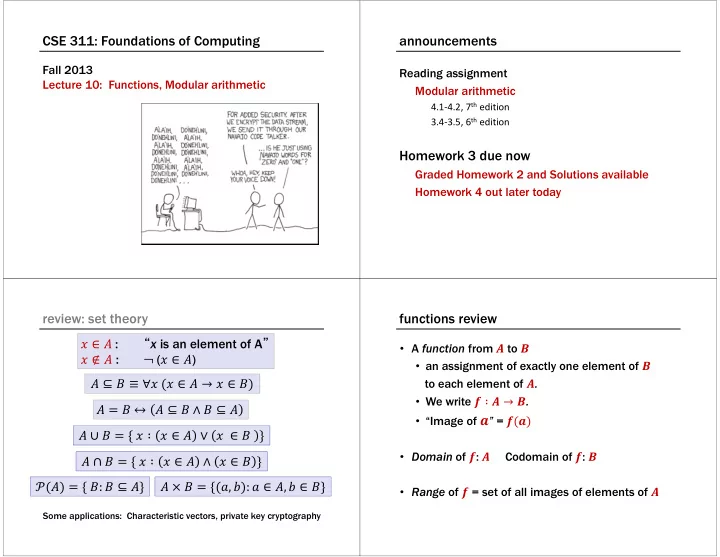

CSE 311: Foundations of Computing announcements Fall 2013 Reading assignment Lecture 10: Functions, Modular arithmetic Modular arithmetic 4.1-4.2, 7 th edition 3.4-3.5, 6 th edition Homework 3 due now Graded Homework 2 and Solutions available Homework 4 out later today “ x is an element of A ” review: set theory functions review � ∈ � : • A function from � to � � ∉ � : ¬ ( � ∈ � ) • an assignment of exactly one element of � � ⊆ � ≡ ∀� (� ∈ � → � ∈ �) to each element of � . • We write � ∶ � → � . � = � ↔ � ⊆ � ∧ � ⊆ � • “Image of � ” = �(�) � ∪ � = { � ∶ � ∈ � ∨ � ∈ � } • Domain of � : � Codomain of � : � � ∩ � = { � ∶ � ∈ � ∧ � ∈ � } �(�) = { �: � ⊆ �} � × � = {(�, �): � ∈ �, � ∈ �} • Range of � = set of all images of elements of � Some applications: Characteristic vectors, private key cryptography
is this a function? one-to-one? onto? image, preimage � � 1 a 1 2 a b 2 c b 3 c 3 d 4 d 4 5 e 6 e number theory (and applications to computing) modular arithmetic • Branch of Mathematics with direct relevance to • Arithmetic over a finite domain computing • In computing, almost all computations are over a • Many significant applications finite domain – Cryptography – Hashing – Security • Important tool set
what are the values computed? what are the values computed? public void Test1() { public void Test2() { byte x = 250; sbyte x = 120; byte y = 20; sbyte y = 20; byte z = (byte) (x + y); sbyte z = (sbyte) (x + y); Console.WriteLine(z); Console.WriteLine(z); } } divisibility division theorem Let a be an integer and d a positive integer. Integers a, b, with a ≠ 0, we say that a divides b if there is an integer k such that b = ka. The notation Then there are unique integers q and r , with a | b denotes “a divides b.” 0 ≤ r < d , such that a = dq + r . q = a div d r = a mod d Note: r ≥ 0 even if a < 0. Not quite the same as a%d
arithmetic mod 7 modular arithmetic a + 7 b = (a + b) mod 7 Let a and b be integers, and m be a positive integer. We say a is congruent to b modulo m if m divides a – b. a × 7 b = (a × b) mod 7 We use the notation a ≡ b (mod m) to indicate that a is congruent to b modulo m. + 0 1 2 3 4 5 6 0 1 2 3 4 5 6 X 0 0 1 1 2 2 3 3 4 4 5 5 6 6 modular arithmetic modular arithmetic Let m be a positive integer. If a ≡ b (mod m) and Let a and b be integers, and let m be a positive integer. Then a ≡ b (mod m) if and only if c ≡ d (mod m), then • a + c ≡ b + d (mod m) and a mod m = b mod m. • ac ≡ bd (mod m)
example n-bit unsigned integer representation • Represent integer x as sum of powers of 2: Let n be an integer. Prove that n 2 ≡ 0 (mod 4) or n 2 ≡ 1 (mod 4) #$% � ! 2 ! If � = ∑ where each b i ∈ {0,1} !&' then representation is b n-1 ...b 2 b 1 b 0 99 = 64 + 32 + 2 + 1 18 = 16 + 2 • For n = 8: 99: 0110 0011 18: 0001 0010 signed integer representation two’s complement representation n bit signed integers, first bit will still be the sign bit n-bit signed integers Suppose −2 #$% < � < 2 #$% Suppose 0 ≤ � < 2 #$% , First bit as the sign, n-1 bits for the value � is represented by the binary representation of � Suppose 0 ≤ � ≤ 2 #$% , −� is represented by the binary representation of 2 # − � 99 = 64 + 32 + 2 + 1 18 = 16 + 2 Key property: Twos complement representation of any number y is equivalent to y mod 2 n so arithmetic works mod 2 n For n = 8: 99: 0110 0011 -18: 1001 0010 99 = 64 + 32 + 2 + 1 18 = 16 + 2 Any problems with this representation? For n = 8: 99: 0110 0011 -18: 1110 1110
signed vs two’s complement two’s complement representation • For 0 < � ≤ 2 #$% , −� is represented by the -7 -6 -5 -4 -3 -2 -1 0 1 2 3 4 5 6 7 binary representation of 2 # − � 1111 1110 1101 1100 1011 1010 1001 0000 0001 0010 0011 0100 0101 0110 0111 Signed • To compute this: Flip the bits of � then add 1: – All 1’s string is 2 # − 1 , so -8 -7 -6 -5 -4 -3 -2 -1 0 1 2 3 4 5 6 7 Flip the bits of � ≡ replace � by 2 # − 1 − � 1000 1001 1010 1011 1100 1101 1110 1111 0000 0001 0010 0011 0100 0101 0110 0111 Two’s complement
Recommend
More recommend